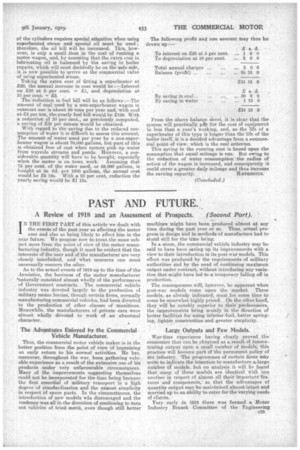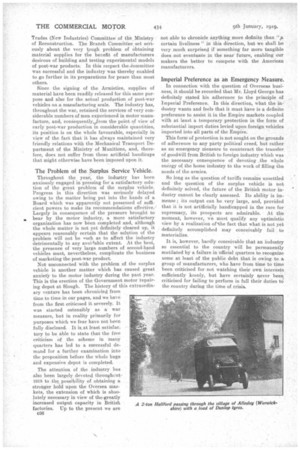PAST AND FUTURE: .
Page 15

Page 16

If you've noticed an error in this article please click here to report it so we can fix it.
A Review of 1918 and an Assessment of Prospects. (Second Part).
IN THE FIRST PART of this article we dealt with the events of the past year as affecting the motor user and also as being likely to affect him in the near future. We propose now to treat the same subject more from the point of view of the motor manufacturing industry, though it must be evident that the interests of the user and of the manufacturer are very closely interlinked, and what concerns one must necessarily concern the other.
As to the actual events of 1918 up to the time of the Armistice, the business of the motor manufacturer 'naturally consisted almost wholly of the performance of Oovernment contracts. The commercial vehicle industry was devoted largely to the production of military motor lorries, though certain firms, normally manufacturing commercial vehicles, had been diverted to the production of ether classes of munitions. Meanwhile, the manufacturers of private cars were almost wholly devoted to work of an abnormal character. .
The Advantages Enjoyed by the Commercial Vehicle Manufacturer.
Thus, the commercial motor vehicle maker is in the better position from the point of view of -organizing an early return to his normal activities. He has, moreover, throughout the war, been gathering valuable experience as a.result of the extensive use of his products under very unfavourable circumstances. Many of the improvements suggesting themselves. could not be incorporated for the time being because the first essential of military transport is a high degree of standardization and the utmost simplicity in respect of spare parts. In the circumstances, the introduction of new models wAs discouraged and the tendency was all in the direction of continuing to turn out vehicles of tried merit, even though still better machines might have been produced almost at any time during the past year or so. Thus, actual progress in design and in methods of manufacture had to stand still for the time being.
In a sense, the commercial vehicle industry may be said to have been saving up its improvements with a view to their introduction in its post-war models. This effect was produced by the requirements of military authorities and by the need of continuing maximum output under contract, without introducing any variation that might have led to a temporary falling off in production.
• The consequences will, however, be apparent when post-war models come upon the market. These models, as already indicated, must for some time to come be somewhat highly priced. On the other hand, they will be notably superior to their predecessors. the improvements being mainly in the direction of better faeilitie-s for using inferior fuel, better springing, lighter construction and greater simplicity.
Large Outputs and Few Models.
War-time experience having clearly proved the economies that eaa be obtained as a result of Concentrating output upon .a small number of models, this practice will become part of-the permanent policy of the industry. 'The programmes of certain firms wily seem to indicate the intention to manufacture alarge number of models, but on analysis it will be fopnd that many of these medels are identical with one another in respect of almost all their important features and components,' so that the advantages of quantity output may be maintained almost intact and married up to an ability to cater fer the varying needs of clients.
Very . early in 1918 there was formed a. Motor Industry Branch Committee of the Engineering n35 Trades (New Industries) Comaiittee of the Ministry of Reconstruction. The Branch COmmittee, set seriously about the very tough problem of obtaining material supplies for the benefit of manufacturers desirous of building and testing experimental models of post-war products. In this respect thesCommittee was successful and the industry was thereby enabled to go further in its preparations for peace than most others.
Since the signing of the Armistice, supplies of material have been readily released for this same purpose and also for the actual production of post-war vehicles on a manufacturing scale. The industry has, throughout the war, retained the services of very considerable numbers of men experienced in motor manufacture, and, consequently,ffrom the point of view of early post-war production in considerable quantities, its position is on the whole favourable, especially in view of the fact that it has always maintained very friendly relations with the Mechanical Transport Department of the Ministry of Munitions, and, therefore, does not suffer from those artificial handicaps that might otherwise have been imposed upon it.
The Problem of the Surplus Service Vehicle. Throughout the year, the industry has been anxiously engaged io pressing for a satisfactory solution of the great problem of the surplus vehicle. Progress in this direction was seriously delayed owing to the matter being put into the hands of a Board which was apparently not possessed of sufficient powers to make its recommendations effective.' Largely in consequence of the pressure brought to
• bear by the motor industry, a more satisfactory organization has now been completed and, although the whole matter is not yet definitely cleared up, it a,ppeare reasonably certain that the solution of the problem will not be such as to affect the industry detrimentally to any avoidable extent. At the best, the presence of very large numbers of second-hand vehicles must, nevertheless, complicate the business of marketing the post-war product.
Not unconnected with the problem of the surplus vehicle is another matter which has caused great anxiety to the motor industry during the past year. This is the erection of the Government motor repairing depot at Slough. The history of this extraordinary venture has been chronicled from time to time in our pages, and we have from the first criticised it, severely. It was started ostensibly as a war measure, but in reality primarily for purposes which we fear have not been fully disclosed. It issat least satisfactory to be able to state that the free criticism of the scheme in many quarters has led to a successful demand for a further examination into the proposition before the whole huge and expensive depot is completed.
The attention of the industry has also been largely. devoted througheut1918 to the possibility of obtaining a stronger hold upon the Oversee markets, the extension of which is absolutely necessary in view of the greatly increased output capacity in British factories. Up to the present we are 036 not able to chronicle anything more definite than "a, certain liveliness "in this direction, but we shall be very much surprised if something far more tangible does not eventuate in the near future, enabling our makers the better to compete with the American manufacturers.
Imperial Preference as an Emergency Measure.
In connection with the question of Overseas business, it should be recorded that Mr. Lloyd George has definitely stated his adherence to the principle of Imperial Preference. In this direction, what the industry wants and feels that it must have is a definite preference to assist it in the Empire markets coupled with at least a temporary protection in the for-in of substantial import duties levied upon foreign vehicles imported into all parts of the Empire.
This form of protection is. not sought on the grounds of adherence to any party political creed, but rather as an emergency nieasure to counteract the transfer of gooclWill from British to foreign industry which was the necessary consequence of devoting the whole energy of the home industry to the work of filling the needs of the armies.
So long as the question of tariffs remains unsettled and the question of the surplus vehicle is not definitely solved, the future of the British motor industry cannot be clearly asseseed. Its ability is immense; its output can be very large, and, provided that it is not artificially handicapped in the race for euprema,cy, its prospects are admirable. At the moment, however, we must qualify any optimistic view by a realization of•the fact that what is not yet definitely accomplished may conceivably fail to materialize.
It is, however, hardly conceivable that an industry so essential to the country will be permanently mutilated by a failure in official quarters to recognize some at least of the public debt that is owing -to a group of manufacturers, who have from time to time been criticised for not watching their own interests sufficiently keenly, but have certainly never been criticised for failing to perform in full their duties tc. the country during the time of crisis.






















